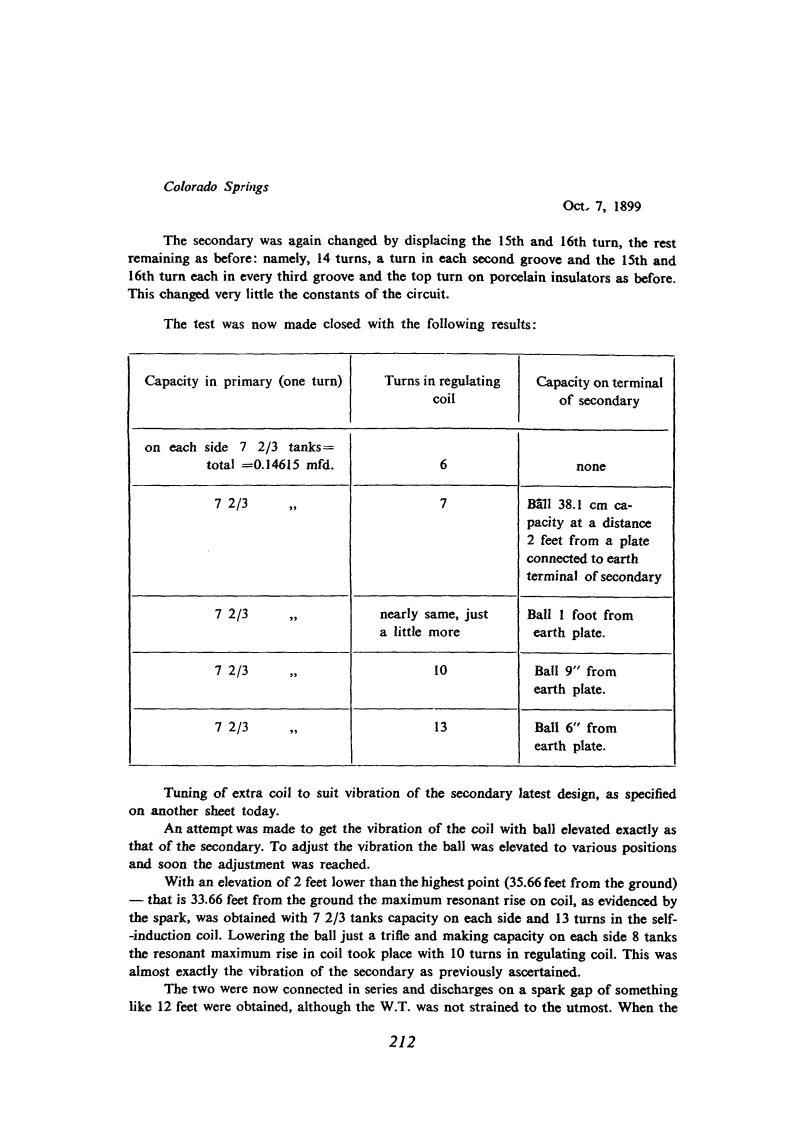
Nikola Tesla Books
Colorado Springs
Oct. 7, 1899
The secondary was again changed by displacing the 15th and 16th turn, the rest remaining as before: namely, 14 turns, a turn in each second groove and the 15th and 16th turn each in every third groove and the top turn on porcelain insulators as before. This changed very little the constants of the circuit.
The test was now made closed with the following results:
| Capacity in primary (one turn) | Turns in regulating coil | Capacity on terminal of secondary |
|---|---|---|
| on each side 7 2/3 tanks = total = 0.14615 mfd. | 6 | none |
| 7 2/3 â | 7 | Bill 38.1 cm capacity at a distanoe 2 feet from a plate connected to earth terminal of secondary |
| 7 2/3 â | nearly same, just a little more | Ball 1 foot from earth plate. |
| 7 2/3 â | 10 | Ball 9" from earth plate. |
| 7 2/3 â | 13 | Ball 6" from earth plate. |
Tuning of extra coil to suit vibration of the secondary latest design, as specified on another sheet today.
An attempt was made to get the vibration of the coil with ball elevated exactly as that of the secondary. To adjust the vibration the ball was elevated to various positions and soon the adjustment was reached.
With an elevation of 2 feet lower than the highest point (35.66 feet from the ground) - that is 33.66 feet from the ground the maximum resonant rise on coil, as evidenced by the spark, was obtained with 7 2/3 tanks capacity on each side and 13 turns in the self-induction coil. Lowering the ball just a trifle and making capacity on each side 8 tanks the resonant maximum rise in coil took place with 10 turns in regulating coil. This was almost exactly the vibration of the secondary as previously ascertained.
The two were now connected in series and discharges on a spark gap of something like 12 feet were obtained, although the W.T. was not strained to the utmost. When the
212
October 7-8
He adjusts the "additional coil" with the intention of adjusting to the same resonant frequencies of the secondary circuit and the new coil. Coil resonant frequency is adjusted by the variation of the metal globe position which is connected to the coils. When he achieves the longer sparks on the "additional coil"; he considers that the coil is in resonance but he does not say how the "additional coil" was connected at this test. From further tests it could be seen that he connected the "additional coil" to the open secondary terminal and he continued experiments with a system of free resonant circuits. By repeated regulating coil inductance adjustments he achieved better oscillator operation and he obtained the current streamers of approximately 5 meters in length. When he removed the sphere, he put on one special coil in order to maintain the same resonant condition in the oscillator. As he did in the past, Tesla determines the oscillator wavelength according to the primary circuit (see for instance June 20). The quarter wavelength he compares with the total secondary wire length, special coil and additional coil (when there are no other coils, than just the secondary coil, he considers that the wire length in the secondary has to amount to a quarter wavelength). Because there is no complete agreement, it is thought that this could eliminate due to errors at measurement of the inductance capacitance and length.

